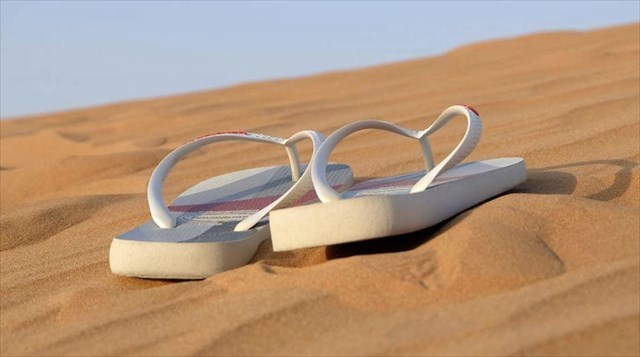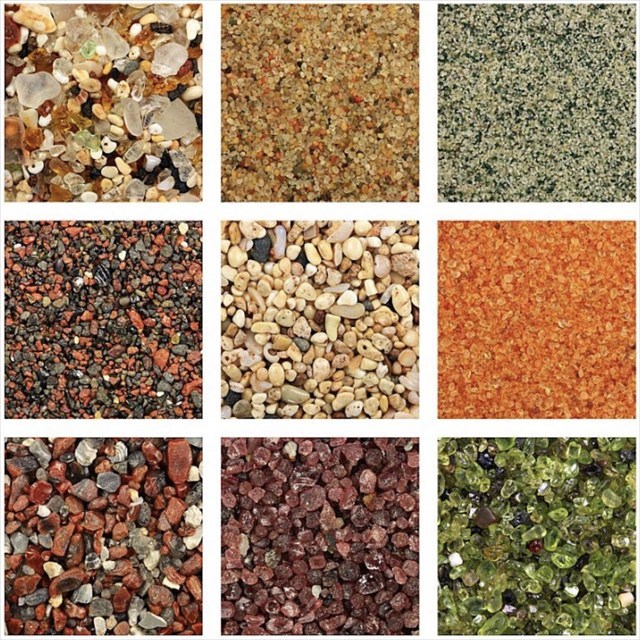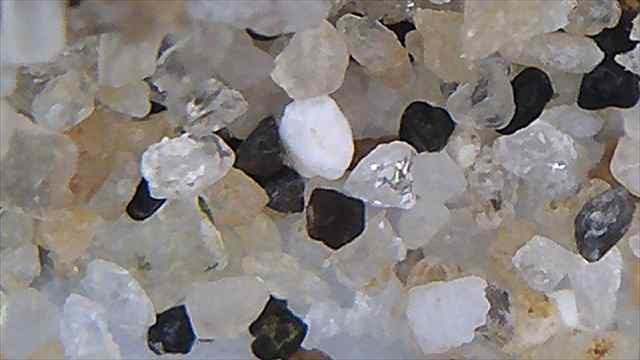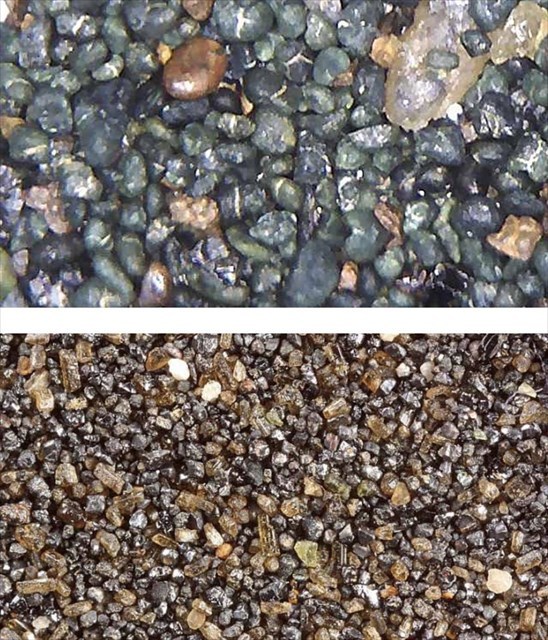

FRANÇAIS
Introduction
Avec cette série de Earthcaches citadines, nous allons nous intéresser aux roches typiques de la région que l’on peut observer en se promenant dans Le Havre. Cette balade va nous permettre de découvrir des spécimens de différentes familles de roches.
La quatrième de la série est le sable (famille des roches sédimentaires).
Pour plus d’information sur les roches sédimentaires, vous pouvez vous référer au descriptif de l’étape 1 de cette série (§ Généralité sur les roches sédimentaires).
Le sable

Dune du Pilat
Le géologue, à la plage, étend sa serviette sur un sédiment détritique meuble dont les grains sont en majorité compris entre 1/16 mm et 2 mm, c’est-à-dire sur du sable.
La nomenclature des sables tient à la fois compte du grain et de la nature des éléments dominants (quartzeux, calcaire…) ou particuliers (micacés, aurifères…). L’étude de la morphologie des grains permet ainsi de préciser les modes de sédimentation et de transport (fluviatiles, marins, dunaires…).
En fonction de la composition en minéraux, le sable peut avoir des aspects très différents.

Échantillons de sable : Chaque photo correspond à un centimètre carré de sable. De gauche à droite: 1. verre de Kauai, Hawaï. 2. Quartz et spinelle, Sri Lanka. 3. glauconite verte, Estonie. 4. Basalte volcanique rougeâtre, Hawaii. 5. corail, Hawaii. 6. Quartz coloré avec de l’hématite, Australie. 7. Hématite, Californie. 8. émeraude, Idaho. 9. Olivine, Hawaii.
Celui de la plupart des plages françaises est fait de silice car c'est ce qui reste de plus dur après l'érosion des montagnes. Il arrive à la mer par les fleuves.
Au Havre, c’est un sable communément trouvé en France. Il a tout de même une particularité si on l’étudie plus en détail. Au microscope, on aperçoit des petites particules noires en plus du quartz (gris translucide) et des feldspaths (minéraux clairs).

Comme pour le sable d’Omaha Beach (voir GC95MQB pour plus de détail), nous avons affaire à un « sable de guerre » dû aux très nombreux bombardements qui ont eu lieu pendant la deuxième guerre mondiale au Havre.
Quand on collecte les grains magnétiques noir, on observe au microscope des grains qui sont assez érodés. La présence de galets de silex sur la plage du Havre favorise surement l’érosion de ces restes d’obus. On peut imaginer que ce phénomène induit une rotondité des éclats métalliques plus prononcée que pour ceux d’Omaha Beach. Ainsi arrondis, ils ressemblent aux grains de magnétite que l’on peut observer en Martinique dans les sables de plages « volcaniques ».

Haut: Grains magnétiques du sable du Havre
Bas: sable de plage volcanique à grain fin de la Martinique. Le minéral noir est de la magnétite.
Les sources bibliographiques
- https://meteorites-cyber-agadir-ma.blogspot.com/p/les-types-de-roches.html
- https://www.futura-sciences.com/planete/dossiers/geographie-dune-pyla-visite-guidee-791/page/3/
- https://www.sandatlas.org/what-is-black-sand/
- https://www.sandatlas.org/sand-types/
Pour valider la Earthcache
ATTENTION, vous êtes sur la plage publique du Havre, veuillez respecter les lieux et ne pas ramasser les galets.
Outils nécessaires pour les questions de terrain : une loupe, une boite d’échantillon pour récolter environ 1 cm3 de sable, un aimant, un peu d’observation et de patiente.
Pour pouvoir valider cette EarthCache, vous devrez répondre correctement aux questions suivantes et ajouter à votre log une photo de vous, de votre GPS ou de votre pseudo au waypoint de la cache (OPTION). Cette photo permettra de valider le « trouvé » en cas de mauvaise réponse aux questions.
Merci d’envoyer vos réponses via mon profil ou via la messagerie geocaching.com, ne les donnez pas dans votre log. Les logs enregistrés sans réponses seront supprimés.
Vous pouvez loguer la cache "trouvé" sans attendre ma confirmation, je vous contacterai en cas de problème.
Rappel concernant les Earthcaches: Il n'y a pas de conteneur à rechercher ni de logbook à renseigner. Il suffit de se rendre sur les lieux, de répondre aux questions et de me renvoyer les réponses.
Question 1 : Sur les 4 processus qui conduisent à la formation des roches sédimentaires, quel est le seul qui n’existe pas dans le cas du sable ?
Question 2 : Rendez-vous au WP de la cache (N49 29.591 E00 05.485) pour récolter un peu de sable. Laissez le sécher et passez un aimant dans le sable sec. Que se passe-t-il ? Pouvez-vous expliquer votre observation ?
Question 3 : Pouvez-vous décrire le sable que vous avez récolté ? Couleur ? Estimation de la taille des grains ?
Question 4 (OPTION) : En arrivant vers le skate-park, récoltez un autre échantillon de sable au WP1 (à gauche du chemin quand vous revenez de la cache). Pouvez-vous le comparer au dernier échantillon récolté ? Que pouvez-vous en déduire ?

Introduction
With this series of urban Earthcaches, we are going to be interested in the typical rocks of the region that we can observe while walking in Le Havre. This walk will allow us to discover specimens of different families of rocks.
The fourth of the series is the sand (family of sedimentary rocks).
For more information on the sedimentary rocks, you can refer to the description of the stage 1 of this series (§ General information on the sedimentary rocks).
The sand
The geologist, at the beach, spreads his towel on a loose detrital sediment whose grains are mostly between 1/16 mm and 2 mm, that is to say on sand.
The nomenclature of sands takes into account both the grain and the nature of the dominant elements (quartz, limestone ...) or particular (micaceous, gold ...). The study of the morphology of the grains allows to specify the modes of sedimentation and transport (fluviatile, marine, dune...).
Depending on the mineral composition, the sand can have very different aspects.
The one of most French beaches is made of silica because it is the hardest thing left after the erosion of mountains. It arrives at the sea by the rivers.
In Le Havre, it is a sand commonly found in France. It has nevertheless a particularity if we study it more in detail. Under the microscope, we can see small black particles in addition to quartz (translucent gray) and feldspars (clear minerals).
As for the Omaha Beach sand (see GC95MQB for more details), we are dealing with a "war sand" due to the numerous bombings that took place during the second world war in Le Havre.
When we collect the black magnetic grains, we observe under the microscope grains that are quite eroded. The presence of pebbles of flint on the beach of Le Havre surely favors the erosion of these remains of shells. We can imagine that this phenomenon induces a more pronounced roundness of the metal shards than for those of Omaha Beach. Thus rounded, they resemble the grains of magnetite that can be observed in Martinique in the sands of "volcanic" beaches.
Bibliographic sources
- https://meteorites-cyber-agadir-ma.blogspot.com/p/les-types-de-roches.html
- https://www.futura-sciences.com/planete/dossiers/geographie-dune-pyla-visite-guidee-791/page/3/
- https://www.sandatlas.org/what-is-black-sand/
- https://www.sandatlas.org/sand-types/
To validate the Earthcache
ATTENTION, you are on the public beach of Le Havre, please respect the place and do not pick up the pebbles.
Tools needed for field questions: a magnifying glass, a sample box to collect about 1 cm3 of sand, a magnet, some observation and patience.
In order to validate this EarthCache, you will have to answer the following questions correctly and add to your log a photo of you, your GPS or your nickname at the waypoint of the cache (OPTION). This photo will validate the "found" in case of wrong answers to the questions.
Please send your answers via my profile or via the geocaching.com messaging system, do not give them in your log. The logs recorded without answers will be deleted.
You can log the "found" cache without waiting for my confirmation, I will contact you in case of problem.
Reminder about Earthcaches: There is no container to search or logbook to fill in. Just go to the location, answer the questions and send me back the answers.
Question 1 : Of the 4 processes that lead to the formation of sedimentary rocks , which is the only one that does not exist in the case of sand?
Question 2 : Go to the WP of the cache (N49 29.591 E00 05.485) to collect some sand. Let it dry and run a magnet through the dry sand. What is happening? Can you explain your observation?
Question 3 : Can you describe the sand you collected? Color? Estimated grain size?
Question 4 (OPTION) : When you get to the skate park, collect another sample of sand at WP1 (on the left side of the path when you come back from the cache). Can you compare it to the last sample you collected? What can you deduce from it?